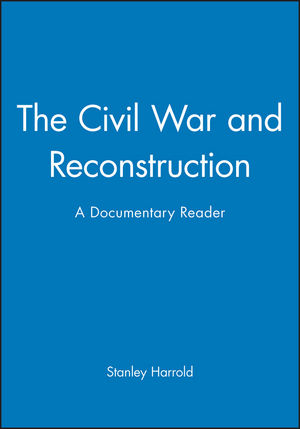|
Textbook
The Civil War and Reconstruction: A Documentary ReaderISBN: 978-1-4051-5664-6
Paperback
236 pages
November 2007, ©2007, Wiley-Blackwell
 Other Available Formats: Hardcover
|
||||||
Introduction.
I: Causes:.
1. [William Lloyd Garrison], Declaration of Sentiments of the American Anti-Slavery Society, 1833.
2. Henry Highland Garnet, Address to the Slaves of the U.S., 1843.
3. John C. Calhoun, Address of the Southern Delegates to Their Constituents,1849.
4. William H. Seward, Irrepressible Conflict, 1858.
5. Ballou’s Pictorial Drawing-Room Companion, Slaves Picking Cotton, 1858.
6. John Brown, Last Speech, 1859.
II: Disunion to War:.
1. South Carolina, Declaration of the Immediate Causes which Induce and Justify the Secession of South Carolina, 1860.
2. John J. Crittenden, Crittenden Compromise Proposal, 1860.
3. Frank Leslie’s Illustrated Newspaper, Jefferson Davis about to Become Provisional President of the Confederacy, 1861.
4. Daniel Decatur Emmett, I wish I was in Dixie’s Land, 1860.
5. Abraham Lincoln, First Inaugural Address, 1861.
6. Alexander H. Stephens, Cornerstone Speech, 1861.
7. Mary Boykin Chesnut, Approaching Conflict at Fort Sumter, 1861.
III: Battles:.
1. William Howard Russell, First Battle of Bull Run, 1861.
2. Walt Whitman, “1861,” 1861.
3. William Monks, Battle of Wilson Creek and Guerilla War in Missouri, 1861-1862.
4. S. Dana Greene, The Monitor Battles The Virginia (Merrimac), 1862.
5. David H. Strother, Battle of Antietam, 1862.
6. Frank A. Haskell, Battle of Gettysburg, 1863.
7. Timothy O’Sullivan, Union Dead on the Gettysburg Battlefield, 1863.
8. Samuel E. Hope, Black-White Guerilla War in Florida, 1863.
9. James Longstreet, Battle of Chickamauga, 1863.
10. Robert E. Lee, Surrender of the Army of Northern Virginia, 1865.
11. Ulysses S. Grant, General Report of Operations, 1865.
IV: Soldiers’ Experiences:.
1. Sarah Rosetta Wakeman, A Woman in the New York Volunteers, 1862-1863.
2. Spencer Glasgow Welch, Preserving Discipline in the Army of Northern Virginia, 1863 3. Unattributed Photograph, Union Soldiers Recovering from Wounds, 1864.
4. Frank Holsinger, Union Soldiers under Fire, 1862-1864.
5. Jenkin Lloyd Jones, Religion and the Daily Lives of Union Soldiers in Alabama, 1864 6. Charles Minor Blackford, A Confederate Officer Observes the Siege of Petersburg, 1864 7. James S. Brisbin, U.S. Colored Cavalry in Virginia, 1864.
8. Unidentified U.S. Sanitary Commission Official, On Soldiers and Prostitutes, City Point, Virginia, 1864.
9. Eliza Frances Andrews, A Confederate Woman on Union Prisoners at Andersonville, 1865.
V: Homefronts:.
1. Mary A. Ward, Confederate Women Prepare Their Men for War, 1861.
2. Regis de Trobriand, Corruption in Washington, D.C., 1862.
3. Julia A. Wilbur, Contraband Camps in Alexandria, Virginia, 1863.
4. [Dora Miller], Life in Besieged Vicksburg, 1863.
5. Sallie Brock Putnam, Richmond Bread Riot, 1863.
6. Illustrated London News, New York City Draft Riot, 1863.
7. John Greenleaf Whittier, Barbara Frietchie, 1864.
VI: Political Perspectives:.
1. Julia Ward Howe, Battle Hymn of the Republic, 1862.
2. Horace Greeley and Abraham Lincoln, Union War Aims, 1862.
3. Joseph E. Brown, State Sovereignty in the Confederacy, 1862.
4. Abraham Lincoln, Emancipation Proclamation, 1863.
5. Clement L. Vallandigham, Northern Opposition to the Civil War, 1863.
6. Frederick Douglass, Men of Color to Arms, 1863.
7. Abraham Lincoln, Gettysburg Address, 1863.
8. Bromley and Company, Democratic Caricature of Republican Racial Policy, 1864.
9. Robert Barnwell Rhett Jr., War for Slavery, 1865.
10. Abraham Lincoln, Second Inaugural Address, 1865.
VII: The Trans-Mississippi West:.
1. U.S. Congress, Homestead Act, 1862.
2. John S. Smith, Sand Creek Massacre, 1864.
3. United States and Sioux Nation, Treaty of Fort Laramie, 1868.
4. Andrew J. Russell, Joining of the Rails, Promontory, Utah, 1869.
VIII: Reconstruction:.
1. Abraham Lincoln, Presidential Reconstruction, 1863.
2. Alexander Gardner, African-American Refugees Amid Ruins of Richmond, 1865.
3. State Convention of the Colored People of South Carolina, Memorial To the Senate and House of Representatives of the United States, 1865.
4. Thaddeus Stevens, Congressional Reconstruction, 1865.
5. United States, Reconstruction Amendments.
6. National Woman Suffrage and Educational Committee, An Appeal to The Women of the United States, 1871.
7. Elias Hill, Ku Klux Klan Terrorism, 1871.
8. Albion W. Tourgee, Failure of Reconstruction, 1879.
Suggested Reading.
.
.
.
.



